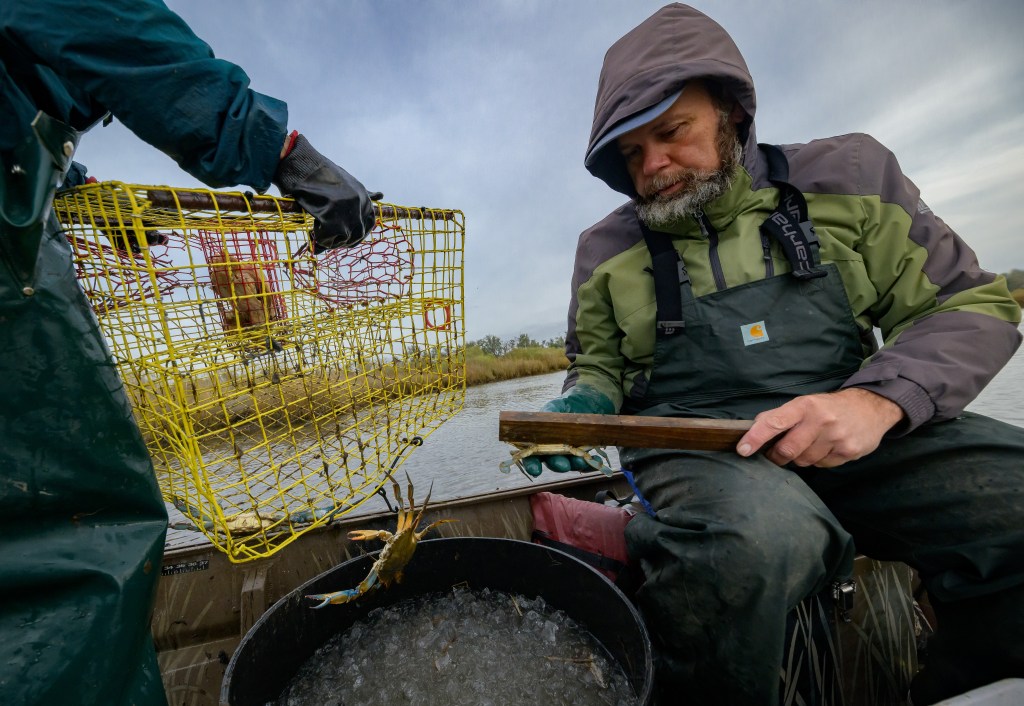Six members of Midwestern farming communities huddled around Louisiana fisherman Lance Nacio earlier this month as he showed family photos and spoke about the shrimping business he inherited from his father and grandfather.
“It’s very much a culture, just like farming,” said Megan Dwyer, a fourth-generation farmer and the director of conservation at the Illinois Corn Growers Association.
Later that evening, the group talked about the Gulf of Mexico dead zone — the primary thing that connects them — over a shrimp boil.
The dead zone is a lifeless expanse caused by excess nutrients, such as nitrogen and phosphorus in farm fertilizers, that flow from Midwestern states via the Mississippi-Atchafalaya River Basin. Once in the Gulf, the nutrients spur algae blooms. When the algae die, they deplete the oxygen, creating a condition known as hypoxia that leaves the water uninhabitable for aquatic life.
“Our fall catch has been terrible,” Nacio told the Tribune. For shrimpers, the fall season began in mid-August, two weeks after the National Oceanic and Atmospheric Association announced that the Gulf of Mexico dead zone was approximately the size of New Jersey this year, the 12th largest measurement on record.
The dead zone is one of several factors, including water temperature and storm patterns, that affect catches. But, it’s the one Midwestern farmers have a direct impact on.
“Why haven’t I thought of doing this before? You know, connecting with some of the fishermen and folks in the Gulf,” said Dwyer, who was inspired to organize this trip to Louisiana after reading the Tribune’s January story on agricultural runoff. She brought five colleagues from Corn Growers Associations in neighboring states and the Illinois Farm Bureau’s associate director of environmental policy to visit Nacio’s operation and venture into the dead zone with experts from the Louisiana Universities Marine Consortium.
“Building personal connections to coastal Louisiana helps people appreciate the complexities of an issue like Gulf hypoxia,” said Jennifer Conover, associate director of education and outreach at the consortium. “We truly enjoyed the exchange of information, ideas, and different perspectives of community members of the Midwest and Louisiana.”
Excess fertilizer application and loose soil are significant contributors to nutrient pollution. State programs are actively educating farmers on farming strategies that reduce fertilizer use and increase soil coverage such as no-till farming and cover crop planting. But, transitioning to these practices is costly and crop yields can be uncertain during the first few years of adoption.
Earlier this month, an Illinois delegation led by Sen. Dick Durbin sent a letter to the U.S. Department of Agriculture asking it to double or even triple the federal conservation funds the state receives. Despite ranking fourth in the nation for planted cropland and tying with Iowa as the top producer of nitrogen runoff, Illinois received less conservation funding than 37 states, according to the letter.
There is a backlog of Illinois farmers waiting for federal assistance to transition to conservation practices that could help shrimpers like Nacio. Approximately 40% of valid applications go unfunded by the agriculture department, stated the letter. The lawmakers blame “inflexible ‘standards” that do not align with the diversity of soils, microclimates, weather patterns and cropping practices in the state.
Cover crops are planted on less than 5% of Illinois farmland, and only 35% is being farmed with conservation tillage and fertilizer approaches, wrote the delegation.
Illinois’ latest progress report concluded that, once again, it is on track to miss its nutrient reduction goals.
Meanwhile, there is a federal goal to reduce the five-year average size of the dead zone to fewer than 1,900 square miles — the size of Rhode Island — by 2035. Right now, the five-year average is more than two times larger than the target.
While Dwyer and her colleagues’ visit did not make the adoption of conservation practices easier, it did create common ground.
“It started a dialogue between people who both depend on Mother Nature,” said Nacio. “They have a better understanding that their actions have consequences a thousand miles away from where they’re farming.”
Dwyer has already scheduled follow-up conversations with the consortium researchers, hopes to host Nacio in Chicago and plans to send more farmers to the Gulf soon.
